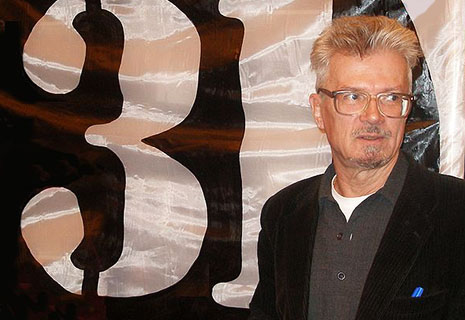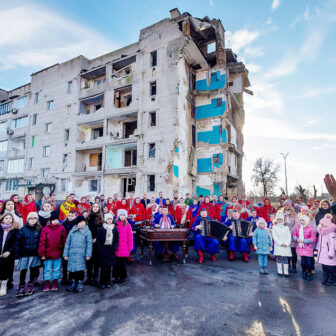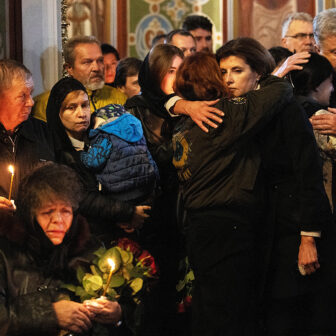ON NEW YEAR’S EVE, Triumphal Square in central Moscow resembled a military encampment on the eve of battle. Pedestrians emerging from Mayakovskaya metro station confronted an intimidating array of manpower and equipment: rows of police buses, massed ranks of police, and a large contingent of OMON Interior Ministry anti-riot troops, colloquially known as “kosmonauts” because of their surreal metallic black helmets. One of the largest squares in Moscow, a symbol of the striving for freedom since the 1960s, had become a cordoned, regimented parade ground.
This army of occupation would have been an appropriate response to the rampage near the Kremlin three weeks earlier. On that occasion, the security forces were caught unprepared by a mob of thousands of ultranationalists who had attended a meeting in memory of Egor Sviridov, a football fan killed in a brawl with a group of men from the Caucasus. To avenge his death, the mourners had marched to Manezh, a shopping complex adjacent to Red Square. When the police dispersed the crowd, the militants fanned out across Moscow’s subway system, and beat up anyone with a complexion dark enough to be suspected of origins in the Caucasus or central Asia. According to a report by Sova, an organisation which monitors racism and xenophobia, some forty people were victims of racially motivated violence that night.
On New Year’s Eve, however, the security forces were confronting a gentler menace. A few thousand law-abiding citizens were preparing to stand quietly in sub-zero temperatures and hear predictable speeches from human rights activists, elderly dissidents, opposition politicians and an ecologist at an officially authorised demonstration. Occasionally they would chant “Putin resign!” or “This our city!” They were attending the latest instalment of Strategy 31, a series of gatherings on the last day of every month with thirty-one days in defence of article 31 of the Russian constitution, the article that affirms that “Citizens of the Russian Federation have the right to assemble peacefully, without arms, to hold assemblies, meetings and demonstrations, festivals and pickets.”
Strategy 31 is the brainchild of Eduard Limonov, the mercurial leader of the outlawed National Bolshevik Party, or NBP. There is perhaps no more controversial figure in contemporary Russia. A young poet in the literary underground of the 1960s, Limonov emigrated to the West in 1974, published an erotically candid autobiographical novel, and established a reputation as an opponent of liberal, pro-Western dissidents like Andrei Sakharov. During the terminal crisis of the Soviet Union, he returned to Moscow and became the enfant terrible of the anti-Yeltsin opposition. The NBP, which he established with the ultranationalist Aleksandr Dugin in 1994, outraged the liberal intelligentsia with its inflammatory rhetoric and its totalitarian symbolism. At demonstrations, its activists chanted “Stalin! Beria! Gulag!” and waved banners that mixed Nazi and Soviet symbols. On one level, this extremism was parodic. The core of the NBP’s membership comprised alienated youth from the heavy-metal rock scene, where the use of totalitarian motifs performed an aesthetic rather than a political function. But Limonov’s writings and conduct during the 1990s offer plenty of material for his detractors. In one essay, he celebrated the Gulag as a defence mechanism that had protected a multiethnic society from the nationalist fanatics who were now unleashing carnage across the ruins of the Soviet empire. A 1992 documentary film records him exchanging small talk with Radovan Karađić on a hill outside Sarajevo and then firing a machine-gun at the besieged city.
Limonov’s metamorphosis into a critic of dictatorship began with his arrest in 2001 on implausible charges of plotting an invasion of Kazakhstan. He served almost two years of a four-year prison sentence. As he experienced Russia’s unreformed penitentiary system first hand, his enthusiasm for the Gulag waned. He criticised the “totalitarian climate” created by the war in Chechnya and reflected on the failure of the democratic revolution of 1991 to open up the political system to people outside the ruling nomenklatura. Taking their cue from their imprisoned leader, the young activists of the NBP played a conspicuous role in the resistance to Russia’s slide into authoritarianism. In a series of sit-ins in government offices, they underlined their embrace of non-violent protest. The authorities retaliated with the full force of the law. In the courts, the young protesters were punished with excessive sentences. In the streets, they became targets of gangs suspected of links with the security forces. Their fortitude in adversity earned cautious admiration from liberal intellectuals like Anna Politkovskaya, who contrasted their idealism with the compromises of the older generation.
The result was a gradual convergence of Limonov with liberal opposition leaders in a coalition called The Other Russia (Drugaya Rossiya), also the title of a collection of Limonov’s prison writings. During 2006–08, The Other Russia staged a series of Dissenters’ Marches, which were intended to challenge the regime in the streets during the lead-up to the next cycle of parliamentary and presidential elections. The violent dispersal of many of these marches became landmarks in the relentless constriction of public space during Putin’s second term. By the time that Dmitrii Medvedev launched his presidential campaign with a denunciation of “legal nihilism,” there were few more glaring examples of that nihilism than the routine flouting of the right to the freedom of assembly guaranteed in article 31 of the constitution.
Strategy 31 was Limonov’s response to the decline of the Dissenters’ Marches and the breakdown of The Other Russia. On both a practical and an ideological level, the linkage of a date and an article of the constitution was an astute move. With the information blockade on state television, as Limonov explained on his blog, demonstrations on a recurring date in a particular place minimised the need for advertising and could facilitate the creation of a protest tradition. The focus on the constitution also had the potential to overcome the factionalism, personal rivalries and ideological disputes that had repeatedly frustrated efforts to coordinate opposition protests. “The most fearless forces of society, regardless of party differences,” argued Limonov in August 2009, “can unite around a living struggle for article 31.” In an effort to assuage the objections of some liberals, he reminded them that Strategy 31 drew upon their own traditions: “You, like everyone, are invited... The Strategy is simple, a continuation of what [Andrei] Sakharov and the dissidents did.”
It was a plausible argument. The dissident movement had begun on 5 December 1965, the anniversary of the adoption of the Stalin constitution, with a small demonstration in Pushkin Square. Among the banners that were quickly ripped down by police officers was the slogan, “Respect the Soviet Constitution,” which was held by the mathematician Aleksandr Esenin-Volpin. Within minutes, the demonstration was over, but Esenin-Volpin had set the tone for decades of protest by activists who became known as pravozashchitniki, a term which is usually mistranslated as “human rights activist,” but which literally suggests a defender of law and of rights, an upholder both of the letter of the law in the constitution and of the inalienable human rights proclaimed by the Universal Declaration of 1948.
Strategy 31’s development was propelled by the convergence of Limonovites and liberal intellectuals around the heritage of the pravozashchitniki. On 12 December 2009, the anniversary of the adoption of the Yeltsin constitution, a group of activists from the liberal Solidarnost (Solidarity) movement staged a “flash mob” in Old Square outside the offices of the presidential administration. Each protester carried a letter of the alphabet. When they lined up, they spelled the exhortation, “Observe the Russian constitution.” Forty-four years after Esenin-Volpin’s bold experiment, the security forces reacted with undiminished aggression, pushing the activists to the snow-covered ground and handcuffing them. Two were punished with forty-eight hours of detention. The contrast between the two protests became the subject of an open letter to President Medvedev from a veteran dissident, Ludmila Alekseeva, the head of the Moscow Helsinki Group. Recalling the events in Pushkin Square on Constitution Day 1965, which she had personally witnessed, Alekseeva lamented that “in contemporary Russia the reaction of the authorities was rather harsher than in Brezhnev’s USSR.”
Alekseeva became one of the first liberals to respond to Limonov’s entreaties. In August 2009, she earned his gratitude by attending the gathering at Triumphal Square as an “observer.” After the brutal suppression of Solidarnost’s flash mob, she reflected in her blog that Strategy 31 was a “wonderful idea because it is easy to remember: every 31st there is a meeting.” A week later, she came to the New Year’s Eve gathering as a participant, dressed for the holiday occasion as Snegurochka, a Russian fairy-tale character who is the helper of Grandfather Frost, Russia’s Santa Claus. The security forces were undeterred by her festive attire. Photographs of Alekseeva, a diminutive and frail woman in her mid-eighties, being hustled to a police van by burly riot police became a public relations disaster for the Kremlin.
TO BEGIN WITH, Strategy 31’s gatherings were effortlessly dispersed by the authorities. Massively outnumbered by police and OMON “kosmonauts,” a few hundred demonstrators were a reminder of the regime’s stranglehold over the public arena and of the demoralisation of the opposition. The brute force of the “kosmonauts” was supplemented by various Kremlin-sponsored youth organisations, which occupied Triumphal Square for functions that ranged from charity to entertainment. The most macabre took place on 31 March, in the aftermath of the terrorist attacks on the Moscow subway. At a time of national mourning, Molodaya Gvardiya (“Young Guard”), the ruling party’s youth wing, staged an outdoors “mourning disco,” with throbbing upbeat music, for thousands of dancing adolescents.
The breakthrough for Strategy 31 came two months later, when one and a half thousand protesters appeared at the square. This influx was heralded by a highly publicised plea for liberalisation from Yurii Shevchuk, the lead singer of the popular rock group DDT, at a meeting between Putin and members of the creative intelligentsia in St. Petersburg. In response to Shevchuk’s impudent query about whether the next round of demonstrations would be smashed by the OMON, Putin lashed out at the demonstrators for obstructing access to children’s hospitals and for inconveniencing people travelling to their dachas. This intemperate diatribe was promptly matched by the batons of the “kosmonauts,” who suppressed the protest on 31 May with their customary brutality.
Opinion-makers were also beginning to acknowledge the existence of Strategy 31. Yuliya Latynina, an outspoken liberal journalist, explained to her listeners on the radio station Ekho Moskvy that she had not commented on the earlier demonstrations “because the 200 people who had assembled, however much one might sympathise with them, are marginals.” But the appearance of a mass of 1500, “despite a strict ban and obvious physical danger” meant that “these are no longer marginals, this is a conscious protest.”
The summer of 2010 also brought signs that the authorities were taking Strategy 31 seriously. In mid July, functionaries from the state’s human rights bureaucracy suggested to the organisers that the demonstration might receive official approval if an application were submitted by a different group of activists. At issue was Limonov, the movement’s founder, who had assumed demonic proportions in propaganda from both the Kremlin and its militant youth organisations. A tentative response to this overture came from Alekseeva and another veteran dissident, Sergei Kovalyov, one of the authors of the constitution’s human rights chapter, which included article 31. In an open letter, they argued that the names of applicants were less important than their common cause. Only a dialogue with the authorities could transform the constitution into a living document. For this dialogue to take place, they argued, it was essential to refute the accusations of the regime’s hawks, who were telling the doves, “Look, these marginals are incapable of negotiations, they don’t need meetings, only scandal!”
This intervention reflected both humanitarian impulses and a deep conviction that opportunities for constructive dialogue with the authorities should not be missed. Unsurprisingly, Alekseeva’s proposal provoked an angry rebuttal from Limonov, and a storm of criticism in the Russian blogosphere for undermining the basic principle of Strategy 31: the unconditional assertion of the constitutionally guaranteed right of all citizens, including the troublesome Limonovites, to freedom of assembly. According to one of her detractors, she was now campaigning for nothing more than the political rights of a privileged caste of human rights activists, not ordinary citizens.
The growing tension between the liberal rights-defenders and the Limonovites culminated in an open rupture at the October demonstration. Against Limonov’s objections, Alekseeva negotiated an agreement for 800 demonstrators, far fewer than the expected figure, to attend an authorised demonstration in part of the square, a substantial expanse of which had now been fenced off because of purported “construction works.” Limonov denounced “Alekseeva’s mutiny” as a regression to the days when the opposition was paralysed by backroom deals with the Kremlin, and demanded: “Freedom for everyone! Freedom without Fences! Freedom without conditions!” The result was the arrival of several thousand people for simultaneous demonstrations, one authorised and one unauthorised, in a relatively confined space. At the end of the meeting, the two crowds merged into one, broke through police lines, and marched in the direction of the government headquarters. Some liberals were euphoric. Ilya Yashin exulted that “Triumphal Square is ours!” Oleg Kozlovskii called the day “a breakthrough, in several senses of the word.” But Limonov, who had been forcibly dragged by “kosmonauts” to the authorised demonstration, claimed that he had never witnessed such “infamy” as this “partnership between the Gestapo and human rights activists.”
The rift within the movement was aggravated by the ultranationalist riot on Manezh square on 11 December. In liberal circles, the rampage provoked hysteria. Limonov dismissed it as the mischief of a small group of racist troublemakers. When his press secretary, Aleksandr Averin, proposed inviting participants in the Manezh events to the next Strategy 31 demonstration, Alekseeva’s organising committee declared that further cooperation with the Limonovites was impossible. Although Averin had made it clear that his invitation was not addressed to racists, only to those who demanded that Sviridov’s killers be brought to justice, he lent credibility to the regime’s new line of attack on the movement. In an interview with Izvestiya, Vladislav Surkov, the deputy head of the presidential administration and the unofficial ideologue of Putin’s presidency, blamed Strategy 31 for creating the “fashion” for unauthorised demonstrations that had culminated in the riot.
Official attitudes towards the next gathering were confused by conflicting signals from the ruling “tandem.” On 16 December, at his annual “conversation” with the nation, a carefully choreographed marathon television broadcast, Putin was asked about the motives of three liberal opposition leaders, Boris Nemtsov, Vladimir Ryzhkov and Vladimir Milov, all participants in Strategy 31. In a moment of pure fury, he replied that they wanted “money and power.” This trio, “together with [disgraced oligarch Boris] Berezovskii,” had stolen many billions in the 1990s, before being “dragged from the feeding trough.” Now they wanted to gorge themselves again, but “if we permit them to do this, they will not limit themselves to billions, they will sell off all of Russia.”
It was a misrepresentation of the past worthy of Stalinist historiography. During his time as deputy premier, Nemtsov had been Berezovskii’s mortal enemy; Milov had only served briefly as a deputy minister after Berezovskii’s departure; and Ryzhkov had never been in government. That Putin could indulge in such mendacious calumny, while ignoring his own personal history as Berezovskii’s candidate for the presidency, was a tribute to the impact of five years of rigid television censorship. Eight days after this anathema, President Medvedev struck a much more relaxed pose in his Christmas Eve interview with three television executives, to whom he suggested that television was diverging from reality. In response to a question about which politicians he regarded as possible allies or rivals, he expressed the heretical proposition that “Kasyanov, Nemtsov, Limonov, Kasparov,” all leading members of the extra-systemic opposition and all banned from state television, were “public politicians,” who each possessed “an electoral base.”
The events of New Year’s Eve in Moscow confirmed that Putin’s invective, not Medvedev’s liberal rhetoric, is the most reliable guide to the conduct of Russia’s security forces. Limonov was seized as he was leaving his apartment. Boris Nemtsov and Ilya Yashin, both Solidarity leaders who had delivered strident anti-Putin speeches in the square, were arrested as they left the demonstration, which was still in progress. As they were dragged to police vans, Lev Ponomaryov, the veteran human rights activist who was chairing the proceedings, made a plea from the platform for the police to explain why they had broken their promise not to interfere with law-abiding participants. There was no response. Dozens of other participants were detained around the square.
When Ilya Yashin was released after five days in captivity, he was careful to downplay the significance of the crackdown: administrative arrests could not be compared to the long prison sentences that had recently been imposed upon Mikhail Khodorkovskii and Platon Lebedev. What had taken place around Triumphal Square, he suggested, was an act of intimidation, “the malevolent gnashing of Putin’s teeth.” That gnashing sent a clear message about the futility of compromise. The fact that Limonov, the paragon of intransigence, and Nemtsov, one of the main orators at the authorised demonstration, were both sentenced to fifteen days of incarceration suggested that the regime drew little distinction between its radical and liberal opponents. This fact may yet facilitate a rapprochement between the two factions. With leading activists behind bars, the squabbles over the timing of applications to the Mayor’s office and over the ownership of the Strategy 31 brand paled into insignificance. By reminding the rights defenders and the Limonovites of their common cause – the defence of the right to freedom of assembly – the regime may have helped to heal the schism that threatened to destroy the movement. •




